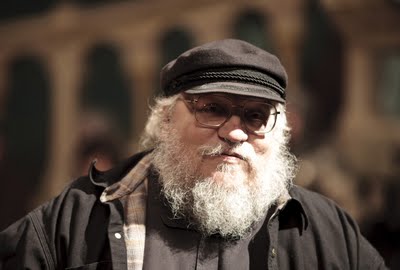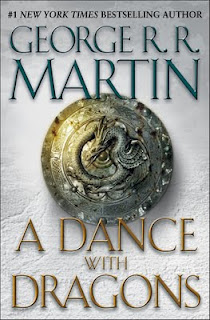The latest Game of Thrones sequel has been a long time coming. Can it maintain the momentum of George R.R. Martin’s winning streak? Our reviewer Kieran Mathers, no stranger to the kingdom of Westeros, finds out…
If you’ve not yet read Kieran’s reviews of the Game of Thrones TV series, you can start here. And come back tomorrow, for the latest instalment!
Numerically, this book is very impressive. It weighs 2.5kg and has over a thousand pages. It costs over £25. It is written from the perspective of eighteen characters. It took over six years to write and picks up plot lines over eleven years old. It features voyages of thousands of miles, a cast of hundreds of thousands, deaths by the thousand. It is the defining case when referring to modern epic literature.
And … I don’t think it’s actually that good.
I wanted it to be good, I really did. I was desperate to dive back in, find the mysteries, discover what had happened to Tyrion, Bran and the many other characters we know and love. And I did… but really not as much I wanted or needed to.
A Dance with Dragons is half companion piece, half sequel to the previous entry in the series, A Feast for Crows, and the point at which it stops being one and becomes the other is crushingly obvious. This builds to a point with the crippled skin-changer Brandon Stark, one of Martin’s strongest characters. The growing understanding of his innate talent is an important thread… until he disappears from the story less than half way through the book, leaving me feeling decidedly short-changed.
To be re-introduced to Tyrion is wonderful, and he remains Martin’s most unique creation. Stunted, frequently unpleasant, occasionally evil and always devious, Tyrion spends most of the first half of the book in shock, having committed a terrible murder and fled Westeros. His behaviour is well characterised and there is a palpable sense of danger in these chapters, which reminds you that in Westeros, ‘Valar Morgalis’ – all men must die.
We also pick up the story of Daenerys, who has come a long way since her marriage to Khal Drogo. Having conquered the city of Meereen in Slaver’s Bay, she is trying to learn how to be queen but, having seen the mess she makes of this one city, it doesn’t look good for the Seven Kingdoms. The decisions she makes here are so downright idiotic that it made me bang my head against the book. She is a sixteen year old girl, true, but so tempered now that she wouldn’t still be making these errors. As with Brandon, it seems that plot has taken the place of character as the main narrative force.
The story also revisits Jon Snow, the final member of the cast we have followed since A Game of Thrones all those years ago. Lord Commander of the Wall, he is building his forces and trying to pre-empt the invasion of both wildlings and the White Walkers but his attempts to unite bitter enemies into a coherent army end in tragedy. The odyssey of this young man, thrown into a situation he is only just capable of dealing with, is by far the most interesting part of the book.
 |
| George R.R. Martin |
The worst part of the novel though, is the extreme number of POV characters. By the end of the book, when the narrative is building pace and suddenly cuts away to yet another character, I was sighing audibly. We have already invested in a large cast of well-loved characters and, as wonderful as it is to see inside the heads of minor players such as Barristan Selmy, they do not merit the extra investment being asked of us
The treatment of Theon Greyjoy, now tortured to the point of losing his identity, highlights another unfortunate aspect of Martin’s writing which has finally become impossible to ignore – he seems to love murderous, amoral psychos.
I get it, George, I really do; Kings aren’t always good, people abuse power and the ruthless often succeed. Complaining about grimness in A Song of Ice and Fire is like complaining about the wet when it’s raining, but Westeros is now a world so denuded of hope and natural justice, it deadens the reader. The only decent characters – that is, decent in comparison to these unmitigated monsters – don’t survive long enough to have an impact and the brutal survivors divvy up the spoils and torture the innocent because they enjoy it. At great length. Over and over again. Then eat them. I dislike it narratively, I dislike it in characters, and I hate it in this book. It stopped me caring because there are very few characters left that I care about.
There are individually powerful chapters, when it feels like an adventure book and matches the skilled style of Patrick O’Brian in its description of sea-faring. And of course it has the always well-rendered descriptions of court politics, with obsequious liars and devious schemers aplenty. It also manages to create a world where things do not exist for the sake of the characters. Nothing is straight forward, nothing is simple and Martin successfully wrong foots the reader, sometimes twisting clichés for surprising outcomes.
But, despite its moments of brilliance, the overall saga of Westeros only grinds forward incrementally, leaving us with little more than we had at the end of A Feast for Crows. This, coupled with the unremitting brutality and surplus of characters, makes A Dance with Dragons hard to recommend to fans, let alone to new readers.
I’m going to read A Game of Thrones again. If I start now, I can probably get the whole saga finished before The Winds of Winter is released.
A Dance with Dragons is available now.
Author: George R.R. Martin.
Publisher: Harper Voyager.
ISBN-13: 978-0002247399. Hardcover edition. Kindle edition.

